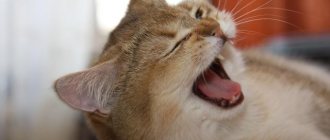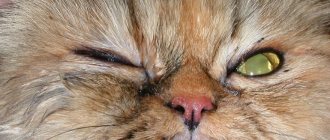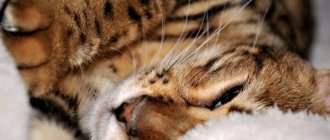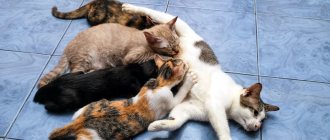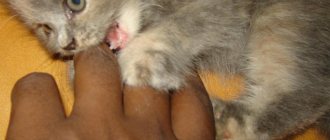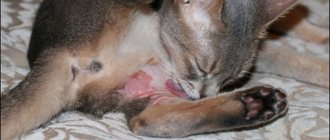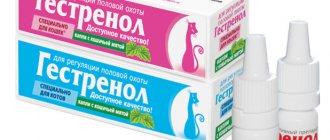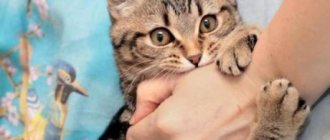Cats, like people, can get colds; they are caused by viruses and microbes that live and multiply in the respiratory organs. Colds rarely occur in cats; normally, the animal’s body is able to cope with the pathogen, but under certain conditions the cat can catch a cold.
The symptoms of a cold in cats are very similar to those in humans, so owners often wonder whether a cat can get it from a person. As a rule, a cold is a viral disease; the virus that causes ARVI in a cat cannot be dangerous to people. A cat can catch a cold from a person only if the disease is caused by a microbial agent to which the pet is sensitive. In other cases, a person’s cold may not be a cause for concern for the pet’s health.
Do not forget about other pets living with a sick cat; they can become infected, so it is recommended to isolate them from each other.
Symptoms of a cold in a cat
The disease affects the eyes, respiratory organs and nasal mucous membranes. Signs of a cold in a cat are as follows:
- Dryness and change in temperature of the nose.
- Signs of body intoxication. The cat becomes weak and lethargic, she refuses food and games. With a mild to moderate cold, the cat easily rises from the bed and stands confidently on its paws. A severe course of the disease is indicated by severe weakness, in which the animal prefers to lie down constantly.
- Runny nose. The fact that the cat has caught a cold is indicated by difficulty breathing and the appearance of clear, thick discharge from the nose. A sick pet breathes through its mouth, which contributes to drying out of the mucous membranes. The animal begins to drink water more often. The cat's mouth is constantly open. If the nasal discharge becomes yellow or greenish in color, it is a sign of a bacterial infection.
- Coughing and sneezing. These signs indicate the launch of protective mechanisms aimed at clearing the respiratory tract of mucus. Coughing and sneezing during a cold is considered normal. In this case, a light coating may appear on the cat’s lip. Severe contamination of fur in the nose and mouth area indicates the presence of more dangerous diseases.
- Inflammation of the mucous membranes of the eyes. Accompanied by photophobia and lacrimation.
- Decreased appetite. The cat may refuse food for several days, while it drinks large amounts of liquid. It is not worth forcing the animal to eat; if the appetite does not return after 3 days, contact a veterinarian.
- Increased body temperature.
Dangerous causes requiring special attention
- Viral, infectious and fungal diseases . Leukemia, immunodeficiency, rhinotracheitis, calicivirus and other dangerous diseases include sneezing in the list of symptoms. These diseases are fatal without timely diagnosis and treatment. At risk are kittens, pregnant and elderly animals, as well as animals picked up from the street or taken from shelters. It is important to understand that vaccination also does not provide 100% protection against infection and these diseases cannot be ruled out even in vaccinated pets!
- Tumors and polyps . If you notice that your pet has constant nasal congestion, sneezing and a runny nose, then one of the reasons may be a new growth in the nasal passage. To diagnose such a problem, you need to go to the clinic for an examination. Most likely, a rhinoscopy (using an endoscope) will be required to remove this tumor.
- Asthma . If, in addition to sneezing, your pet experiences wheezing, shortness of breath, or coughing, this may be a manifestation of asthma. In this case, you should contact the clinic for a more accurate diagnosis and prescription of medications.
- Dental problems . Often sneezing occurs due to dental problems. At the same time, the pet rubs its mouth and nose with its paws, and it often has difficulty eating. Examine your cat's oral cavity: if you notice plaque on the teeth, redness of the gums, an unpleasant odor, or drooling, you should consult a dentist.
- Worms . Infection can manifest itself in different ways, including a runny nose with wheezing. If you notice abnormal bowel movements, weight loss, dull hair, or a rounded belly, you need to get tested and treat parasites with medications recommended by your doctor.
In these cases, it is dangerous to self-medicate a runny nose; you need to go to the clinic as soon as possible.
You need to go to the vet urgently if:
- the cat sniffles, breathes with its mouth open;
- in addition to mucus, blood or pus is discharged from the nose;
- there is an increase in temperature - the pet has a hot nose and paw pads;
- there is redness of the eyes, lacrimation, and formation of pus;
- lethargy, anxiety, refusal of food and water, weight loss are manifested.
Why does a cat get a cold?
Many animal lovers wonder whether cats get colds. A healthy animal rarely gets respiratory infections, since its immune system fights viruses well. The causes of colds include the following factors:
- Elderly age. After 10 years, the animal develops chronic diseases that weaken the body's defenses. The cat becomes vulnerable to bacterial and viral infections.
- Violation of the rules of care. High humidity and low indoor air temperature are the most common causes of colds in cats.
- Poor nutrition. The state of immunity is negatively affected by vitamin deficiency, which occurs when low-quality or monotonous foods are included in the diet.
- Sudden change in temperature. Cats react acutely to changes in temperature in the house. During the warm season, you should not turn on the air conditioner in the room where your pet lives. Hypothermia often occurs in cats that have access to the street. Wet wool disrupts thermoregulation. The animal freezes within a few minutes, especially in windy weather. The cause of the disease can also be poor drying of the coat after bathing.
- Chronic diseases, malignant tumors. These pathologies reduce the body's defenses, which is why a cat can catch a cold from a person.
Diagnostics:
Before prescribing treatment, the attending physician must conduct a diagnosis of the cat’s body to identify the exact cause of the disorder. The fact is that the symptoms of colds are similar to other pathologies in animals. It is very important to exclude the occurrence of dangerous diseases and make an accurate diagnosis
. To ensure that the research result is accurate, certain measures are taken. Let's look at the most basic of them:
- initial examination by a veterinarian - involves a visual assessment of the patient’s condition. It is necessary to give the doctor detailed information about the change in the pet’s condition and its actions over the last 72 hours;
- blood test - biochemical and general analysis of blood cells allows doctors to determine the condition of the body and internal organs as a whole;
- Ultrasound examination and radiography - these procedures are prescribed additionally if the situation requires it.
What complications can a cold cause?
A cold in a cat, especially a kitten, can lead to disruption of the functioning of internal organs. If left untreated, the viral infection affects the bronchi, lungs, joints and kidneys. The animal’s immunity decreases, and inflammatory processes caused by bacteria occur:
- pneumonia (the disease is accompanied by damage to the lung tissue, often leading to the death of the animal);
- bronchitis (characterized by inflammation of the mucous membranes of the bronchi, the appearance of a cough with the discharge of thick sputum and breathing problems);
- bacterial arthritis (accompanied by pain and decreased joint mobility);
- pyelonephritis and cystitis (inflammatory processes in the kidneys and bladder lead to disruption of urine production processes and poisoning of the body with metabolic products).
Treatment at home: what medications can be given?
There are no special medications to treat colds in cats. Veterinarians recommend treating the disease with drugs that boost immunity and relieve symptoms. During therapy, the pet needs to be provided with comfortable living conditions, proper nutrition and rest.
Antibiotics
Colds in cats are treated with antibiotics when bacterial infections occur. Drugs must be selected with caution. Not only the recovery, but also the life of the pet depends on this. The most commonly prescribed medications for cats are:
- oxytetracycline;
- gentamicin;
- amoxicillin;
- chloramphenicol;
- kanamycin.
It is important to correctly calculate the dose of the drug, which depends on the weight, age and general condition of the cat’s body. For colds in cats, treatment at home involves following the administration regimen drawn up by the doctor. Otherwise, the drug is ineffective. The course of antibacterial therapy lasts 7-10 days. You should not interrupt treatment, even if the symptoms disappear after 3-4 days. If you refuse further administration of antibiotics, the infection may become chronic.
Injections
Both antibiotics and immunostimulating agents are injected. The administration of vitamins has a positive effect on the cat's condition. If the cold is severe, the animal can be treated with interferon. The product has a high price and has a number of side effects. It can be replaced with immunoglobulins - antibodies obtained from a recovered animal. They act only in the first days of illness. It is recommended to give injections to your cat at a veterinary clinic.
Nasal rinsing
The procedure helps clear the nasal passages of mucus secretions and restore breathing. For this purpose the following drugs are used:
- 2% zinc sulfate solution;
- 3% boric acid;
- 0.5% tannin solution;
- a mixture of adrenaline and novocaine.
A small amount of liquid is drawn into a pipette or syringe without a needle. The animal is placed on its side, holding its head. The medicine is injected into the nasal passage and the animal is allowed to lie down. After washing, you can drip a mixture of 1% methanol and fish oil. This remedy softens the mucous membranes, eliminating signs of irritation and inflammation.
Use of human medicines
In treating a cat, you can use some of the remedies used to treat colds in humans. Derinat and Nazivin drops help to cope with a runny nose. The recommended single dose for an adult cat is 1 drop. The use of some medications from a human medicine cabinet can be fatal to a pet. Antipyretics based on paracetamol and aspirin are toxic to cats. In addition, due to the small weight of the animal, it can be difficult to calculate and obtain the required dose of the drug.
Prevention
A cold is not dangerous for an animal with normal immunity, but the disease causes discomfort to the cat and is quite difficult to treat. It is much easier to prevent infection. The following measures help with this:
- Proper care of animals. For the first few weeks of life, kittens should be kept in a warm, draft-free room. Trays and sleeping places for adult animals should also not be in rooms with cold air.
- Gradual adaptation to the street. You need to start this procedure in the warm season. The cat is allowed outside for several hours. In this case, you need to ensure that the animal does not become hypothermic. In rainy and windy weather, walks are avoided.
- Proper bathing. The cat needs to be bathed with warm water. After the procedure, the fur is thoroughly dried with a towel, while the pet should be in a warm room.
- Proper nutrition. The diet should include balanced food and sufficient fluids. Do not give your cat cold food or water.
Cats with a compromised immune system are susceptible to colds, so you need to take care to increase the body's defenses. Vitamin supplements selected by a veterinarian help with this. Vaccination also helps protect your cat from diseases.
The cat has a cold and is sneezing: what to do?
If your pet is sneezing, coughing, the nose is dry and hot, the eyes are watery, there is no appetite, breathing is difficult, you should give the cat first aid.
Algorithm of actions:
- Carry out a visual inspection, analyze whether the disease is the result of a viral infection.
- Place the sick person in a comfortable, warm place, making sure there are no drafts.
- Put a heating pad on if the animal is cold.
- Give plenty of warm water and milk. Cold drinks are prohibited.
- Massage your body to increase blood circulation.
- Offer nutritious food.
If after two or three days the pet’s condition remains unchanged, you must visit a veterinary clinic, where the doctor will make an accurate diagnosis.

